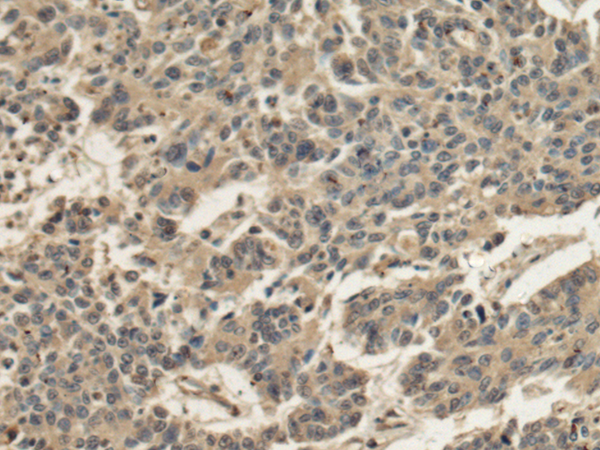
| WB | 咨询技术 | Human,Mouse,Rat |
| IF | 咨询技术 | Human,Mouse,Rat |
| IHC | 1/150-1/300 | Human,Mouse,Rat |
| ICC | 技术咨询 | Human,Mouse,Rat |
| FCM | 咨询技术 | Human,Mouse,Rat |
| Elisa | 1/5000-1/10000 | Human,Mouse,Rat |
| Host/Isotype | Rabbit IgG |
| Antibody Type | Primary antibody |
| Storage | Store at 4°C short term. Aliquot and store at -20°C long term. Avoid freeze/thaw cycles. |
| Species Reactivity | Human, Mouse, Rat |
| Immunogen | Fusion protein of human KATNA1 |
| Formulation | Purified antibody in PBS with 0.05% sodium azide and 50% glycerol. |
+ +
以下是3篇关于KATNA1抗体的参考文献及其简要摘要:
---
1. **标题**: *"Katanin, a microtubule-severing protein, is a novel AAA ATPase that targets to the centrosome using a WD40-containing subunit"*
**作者**: Hartman, J.J., et al.
**摘要**: 该研究首次克隆并鉴定了KATNA1(katanin p60亚基),开发了特异性抗体。研究发现KATNA1通过其WD40结构域与中心体结合,证实其在微管切割中的关键作用,并揭示了其依赖ATP酶的活性调控机制。
---
2. **标题**: *"Dynamic localization of KATNA1 in mitotic spindles and its role in chromosome segregation"*
**作者**: Sudo, H., & Maru, Y.
**摘要**: 通过免疫荧光和KATNA1抗体标记,研究证明KATNA1在有丝分裂纺锤体中动态富集,敲低实验显示其缺失导致染色体分离异常,提示其在维持基因组稳定性中的功能。
---
3. **标题**: *"KATNA1 deficiency disrupts neuronal migration and cortical development via dysregulated microtubule dynamics"*
**作者**: Meka, D.P., et al.
**摘要**: 利用KATNA1特异性抗体进行组织染色,研究发现KATNA1缺失导致神经元迁移障碍和小头畸形表型,机制与微管动力学紊乱相关,为神经发育疾病提供了潜在病理依据。
---
4. **标题**: *"Antibody-based profiling of microtubule severing proteins in human cancers"*
**作者**: Zhang, L., et al.
**摘要**: 研究通过多种抗体(包括KATNA1抗体)分析了微管切割蛋白在肿瘤中的表达谱,发现KATNA1在胶质母细胞瘤中高表达,并与患者预后不良相关,提示其作为治疗靶点的潜力。
---
以上研究均通过KATNA1抗体进行蛋白定位、功能验证或疾病相关性分析,涵盖基础机制与临床转化方向。
**Background of KATNA1 Antibody**
KATNA1 (katanin p60 ATPase-containing subunit A1) is a critical subunit of the katanin complex, an ATPase responsible for severing microtubules, a process essential for cellular processes like mitosis, neuronal development, and cytoskeletal remodeling. The katanin complex, composed of the catalytic p60 subunit (KATNA1) and a regulatory p80 subunit (KATNB1), regulates microtubule dynamics by generating internal breaks, enabling rapid reorganization of microtubule networks during cell division or differentiation.
KATNA1 antibodies are tools used to detect and study the expression, localization, and function of the KATNA1 protein in various biological contexts. These antibodies have been instrumental in research exploring microtubule-related mechanisms in cancer (e.g., mitotic defects), neurodevelopmental disorders, and neurodegenerative diseases. Studies using KATNA1 antibodies have revealed its role in neuronal migration, axon growth, and spindle formation, as well as its interaction with proteins like tubulin, MEI1. and components of the ubiquitin-proteasome system.
Commercial KATNA1 antibodies are typically raised in hosts like rabbits or mice, validated for applications such as Western blotting, immunofluorescence, and immunohistochemistry. Researchers utilize these antibodies to investigate KATNA1 dysregulation linked to pathologies, including microcephaly, intellectual disability, and certain cancers. Recent work also explores its involvement in cilia formation and response to cellular stress, highlighting its broad functional relevance. Proper validation via knockout controls or siRNA is critical to ensure antibody specificity in experimental models.
×